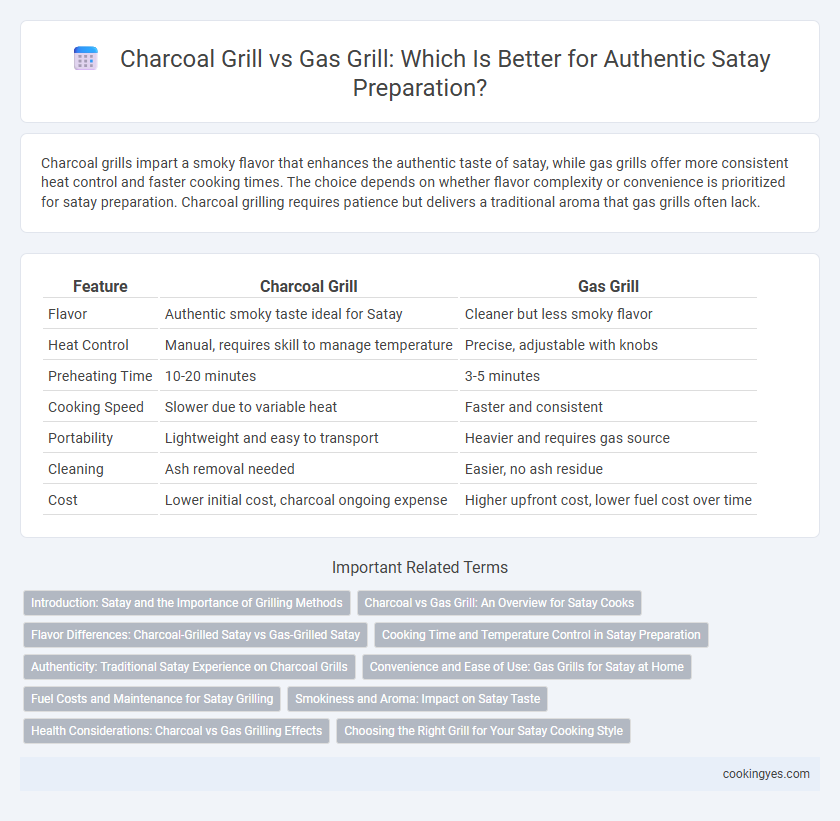Charcoal grills impart a smoky flavor that enhances the authentic taste of satay, while gas grills offer more consistent heat control and faster cooking times. The choice depends on whether flavor complexity or convenience is prioritized for satay preparation. Charcoal grilling requires patience but delivers a traditional aroma that gas grills often lack.
Table of Comparison
| Feature | Charcoal Grill | Gas Grill |
|---|---|---|
| Flavor | Authentic smoky taste ideal for Satay | Cleaner but less smoky flavor |
| Heat Control | Manual, requires skill to manage temperature | Precise, adjustable with knobs |
| Preheating Time | 10-20 minutes | 3-5 minutes |
| Cooking Speed | Slower due to variable heat | Faster and consistent |
| Portability | Lightweight and easy to transport | Heavier and requires gas source |
| Cleaning | Ash removal needed | Easier, no ash residue |
| Cost | Lower initial cost, charcoal ongoing expense | Higher upfront cost, lower fuel cost over time |
Introduction: Satay and the Importance of Grilling Methods
Satay, a popular Southeast Asian dish, relies heavily on grilling methods to achieve its signature smoky flavor and tender texture. Charcoal grills infuse satay with an authentic smoky aroma and high heat that caramelizes the marinade, enhancing its taste. Gas grills offer precise temperature control and convenience but often lack the deep smoky essence essential for traditional satay preparation.
Charcoal vs Gas Grill: An Overview for Satay Cooks
Charcoal grills infuse satay with a smoky, authentic flavor due to slow, uneven heat distribution that enhances the meat's caramelization and aroma. Gas grills offer precise temperature control and quicker cooking times, allowing consistent results but often lacking the distinctive charred taste essential for traditional satay. Satay cooks prefer charcoal grills to achieve the quintessential smoky depth that defines classic Southeast Asian satay recipes.
Flavor Differences: Charcoal-Grilled Satay vs Gas-Grilled Satay
Charcoal-grilled satay offers a distinct smoky aroma and rich, complex flavors due to the natural wood smoke and high heat, which caramelizes the marinade and enhances the meat's juiciness. Gas-grilled satay provides more controlled cooking with consistent heat, resulting in cleaner, less smoky taste but a slightly less intense char flavor. The choice between charcoal and gas grilling significantly influences the depth of flavor, with charcoal preferred for traditional, aromatic satay and gas favored for convenience and precision.
Cooking Time and Temperature Control in Satay Preparation
Charcoal grills provide higher maximum temperatures and impart a distinctive smoky flavor essential for authentic satay, but require longer preheating and less precise temperature control. Gas grills offer rapid ignition and consistent, adjustable heat levels, allowing for shorter cooking times and more controlled grilling of satay skewers. For perfect satay preparation, balancing charcoal's intense heat with gas grill's precise temperature regulation optimizes cooking efficiency and flavor.
Authenticity: Traditional Satay Experience on Charcoal Grills
Charcoal grills impart a distinctive smoky aroma and flavor essential to the traditional Satay experience, enhancing the meat's juiciness and char. The natural, uneven heat from charcoal creates authentic grill marks and caramelization, which a gas grill often cannot replicate. Many Satay chefs prefer charcoal for its ability to infuse satay skewers with a rich, deep taste that defines genuine Southeast Asian street food.
Convenience and Ease of Use: Gas Grills for Satay at Home
Gas grills offer unparalleled convenience and ease of use for preparing satay at home, thanks to their quick ignition and precise temperature control. Unlike charcoal grills, gas grills eliminate the need for managing hot coals, reducing setup and cleanup time significantly. This controlled environment ensures consistent cooking results, making gas grills ideal for home cooks seeking efficiency and reliability in satay preparation.
Fuel Costs and Maintenance for Satay Grilling
Charcoal grills for satay preparation typically incur lower initial fuel costs due to the affordability of charcoal compared to propane used in gas grills. Maintenance of charcoal grills often requires more effort, involving ash disposal and frequent cleaning to prevent buildup, while gas grills demand regular checks of burners and gas lines but provide easier overall upkeep. Choosing between the two depends on balancing the lower fuel expenses of charcoal with the streamlined maintenance benefits of gas grills for consistent satay cooking.
Smokiness and Aroma: Impact on Satay Taste
Charcoal grills infuse satay with a distinctive smokiness and rich aroma, enhancing the meat's flavor through natural wood smoke that penetrates the skewers deeply. Gas grills provide consistent heat but lack the complex smoky compounds from burning charcoal, resulting in a cleaner taste but less aromatic intensity. The choice between charcoal and gas grilling significantly influences the savory depth and authentic satay experience, with charcoal preferred for traditional smoky and aromatic qualities.
Health Considerations: Charcoal vs Gas Grilling Effects
Charcoal grilling imparts a smoky flavor to satay but can produce carcinogenic compounds such as polycyclic aromatic hydrocarbons (PAHs) and heterocyclic amines (HCAs) due to fat dripping onto hot coals. Gas grilling offers more temperature control and generally produces fewer harmful chemicals, reducing health risks associated with grilling. Choosing gas grilling can help minimize exposure to potential carcinogens while still achieving properly cooked satay.
Choosing the Right Grill for Your Satay Cooking Style
Charcoal grills impart a distinct smoky flavor and high heat that enhances satay's traditional taste and caramelization, making them ideal for authentic, rustic preparation. Gas grills offer precise temperature control and convenience, allowing for consistent cooking and easy adjustments during grilling, which suits a more controlled cooking style. Selecting the right grill depends on whether you prioritize flavor complexity with charcoal or ease and consistency with gas for your satay cooking style.
Charcoal grill vs Gas grill for Satay preparation Infographic

 cookingyes.com
cookingyes.com